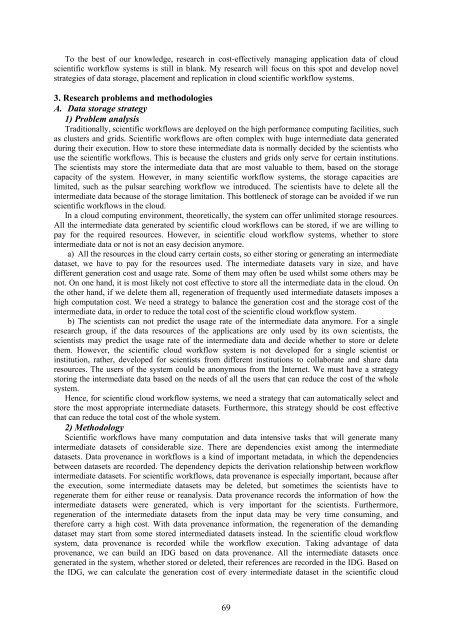Workshop proceeding - final.pdf - Faculty of Information and ...
Workshop proceeding - final.pdf - Faculty of Information and ...
Workshop proceeding - final.pdf - Faculty of Information and ...
You also want an ePaper? Increase the reach of your titles
YUMPU automatically turns print PDFs into web optimized ePapers that Google loves.
To the best <strong>of</strong> our knowledge, research in cost-effectively managing application data <strong>of</strong> cloud<br />
scientific workflow systems is still in blank. My research will focus on this spot <strong>and</strong> develop novel<br />
strategies <strong>of</strong> data storage, placement <strong>and</strong> replication in cloud scientific workflow systems.<br />
3. Research problems <strong>and</strong> methodologies<br />
A. Data storage strategy<br />
1) Problem analysis<br />
Traditionally, scientific workflows are deployed on the high performance computing facilities, such<br />
as clusters <strong>and</strong> grids. Scientific workflows are <strong>of</strong>ten complex with huge intermediate data generated<br />
during their execution. How to store these intermediate data is normally decided by the scientists who<br />
use the scientific workflows. This is because the clusters <strong>and</strong> grids only serve for certain institutions.<br />
The scientists may store the intermediate data that are most valuable to them, based on the storage<br />
capacity <strong>of</strong> the system. However, in many scientific workflow systems, the storage capacities are<br />
limited, such as the pulsar searching workflow we introduced. The scientists have to delete all the<br />
intermediate data because <strong>of</strong> the storage limitation. This bottleneck <strong>of</strong> storage can be avoided if we run<br />
scientific workflows in the cloud.<br />
In a cloud computing environment, theoretically, the system can <strong>of</strong>fer unlimited storage resources.<br />
All the intermediate data generated by scientific cloud workflows can be stored, if we are willing to<br />
pay for the required resources. However, in scientific cloud workflow systems, whether to store<br />
intermediate data or not is not an easy decision anymore.<br />
a) All the resources in the cloud carry certain costs, so either storing or generating an intermediate<br />
dataset, we have to pay for the resources used. The intermediate datasets vary in size, <strong>and</strong> have<br />
different generation cost <strong>and</strong> usage rate. Some <strong>of</strong> them may <strong>of</strong>ten be used whilst some others may be<br />
not. On one h<strong>and</strong>, it is most likely not cost effective to store all the intermediate data in the cloud. On<br />
the other h<strong>and</strong>, if we delete them all, regeneration <strong>of</strong> frequently used intermediate datasets imposes a<br />
high computation cost. We need a strategy to balance the generation cost <strong>and</strong> the storage cost <strong>of</strong> the<br />
intermediate data, in order to reduce the total cost <strong>of</strong> the scientific cloud workflow system.<br />
b) The scientists can not predict the usage rate <strong>of</strong> the intermediate data anymore. For a single<br />
research group, if the data resources <strong>of</strong> the applications are only used by its own scientists, the<br />
scientists may predict the usage rate <strong>of</strong> the intermediate data <strong>and</strong> decide whether to store or delete<br />
them. However, the scientific cloud workflow system is not developed for a single scientist or<br />
institution, rather, developed for scientists from different institutions to collaborate <strong>and</strong> share data<br />
resources. The users <strong>of</strong> the system could be anonymous from the Internet. We must have a strategy<br />
storing the intermediate data based on the needs <strong>of</strong> all the users that can reduce the cost <strong>of</strong> the whole<br />
system.<br />
Hence, for scientific cloud workflow systems, we need a strategy that can automatically select <strong>and</strong><br />
store the most appropriate intermediate datasets. Furthermore, this strategy should be cost effective<br />
that can reduce the total cost <strong>of</strong> the whole system.<br />
2) Methodology<br />
Scientific workflows have many computation <strong>and</strong> data intensive tasks that will generate many<br />
intermediate datasets <strong>of</strong> considerable size. There are dependencies exist among the intermediate<br />
datasets. Data provenance in workflows is a kind <strong>of</strong> important metadata, in which the dependencies<br />
between datasets are recorded. The dependency depicts the derivation relationship between workflow<br />
intermediate datasets. For scientific workflows, data provenance is especially important, because after<br />
the execution, some intermediate datasets may be deleted, but sometimes the scientists have to<br />
regenerate them for either reuse or reanalysis. Data provenance records the information <strong>of</strong> how the<br />
intermediate datasets were generated, which is very important for the scientists. Furthermore,<br />
regeneration <strong>of</strong> the intermediate datasets from the input data may be very time consuming, <strong>and</strong><br />
therefore carry a high cost. With data provenance information, the regeneration <strong>of</strong> the dem<strong>and</strong>ing<br />
dataset may start from some stored intermediated datasets instead. In the scientific cloud workflow<br />
system, data provenance is recorded while the workflow execution. Taking advantage <strong>of</strong> data<br />
provenance, we can build an IDG based on data provenance. All the intermediate datasets once<br />
generated in the system, whether stored or deleted, their references are recorded in the IDG. Based on<br />
the IDG, we can calculate the generation cost <strong>of</strong> every intermediate dataset in the scientific cloud<br />
69
















